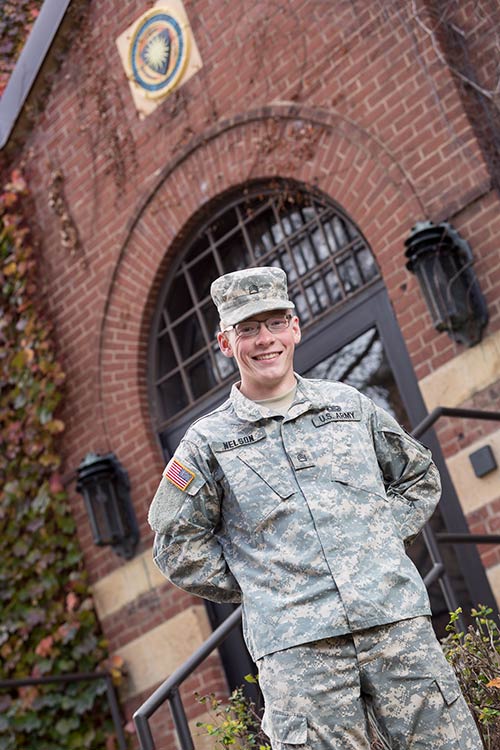How did ROTC cadet spend his summer? Jumping out of planes and serving internship at night vision research laboratory
October 21, 2016
By Michael Nelson ’18

Michael Nelson '18 is a member of the Fighting Saints Battalion Army ROTC program.
Photo: Tommy O'Laughlin '13
Editor's note: Michael Nelson is a junior at Saint John's University, and a member of the Fighting Saints Battalion Army ROTC program. Through the ROTC program, he was able to attend the Army's Basic Airborne Course from June 1-24 at Fort Benning, Georgia, and an internship at the Night Vision Electronic Sensory Directorate (NVESD) from July 21-Aug. 17 at Fort Belvoir, Virginia.
Nelson, an applied physics major from Vilseck, Germany, shared his experiences from the summer.
I looked to my left and then to my right. It was hard to hear anything over the sound of the roaring engines of the C-130, a personnel carrying airplane, but I didn't need to hear to know that everyone was nervous. Throughout the plane everyone had stone-faced expressions, and I can only imagine how I looked.
Everyone was startled at the jumpmaster's first command. "Outboard personnel stand up! Inboard personnel stand up! Hook Up!"
Everyone who would jump during this pass over the drop zone stood up, including myself. I was lined up to be the fifth person to exit the door. We trained for two straight weeks for this moment, and we learned to trust our equipment. "Green Light Go!"
As the first person exited the door, I felt my static line shake violently and then the moment became real. As I marched forward, I visualized the moment I would give the jumpmaster my static line, pivot and then exit. I visualized it, and then it happened for real. Once the parachute opened up, I felt a calmness unlike anything I have ever experienced. The glide toward the ground was true bliss.
Airborne school is divided into three phases: Ground Week, Tower Week and Jump Week. Ground Week is spent learning the basics of military parachuting, namely the Parachute Landing Fall (PLF) and what to do when exiting an aircraft. The PLF is very important because upon landing you hit the ground at speeds of about 20 miles per hour. Tower Week consists of jumping out of 34-foot and 250-foot-tall towers, for additional practice. Jump Week is the last week of training and this is when we finally utilized our training to jump out of an aircraft five times at just over 1,000 feet. Due to the proximity to the ground, a static line connected to a cable inside the aircraft is used for all the jumps. This is in lieu of a ripcord, so as you exit the plane, the parachute deploys automatically.
 Airborne school is run very similarly to when it first opened its doors in 1942, and can get grueling under the heat and humidity of the Georgia summer. After close to a month of training, I was happy to go home, and I readied myself for my internship at NVESD.
Airborne school is run very similarly to when it first opened its doors in 1942, and can get grueling under the heat and humidity of the Georgia summer. After close to a month of training, I was happy to go home, and I readied myself for my internship at NVESD.
NVESD is the Army's premier research laboratory for night vision and thermal optics equipment. While I worked at its facilities, I experienced close contact to a multitude of high end optical devices, with many functions for each.
On the last day of my internship, I found myself behind a M110 sniper rifle that was outfitted with a thermal scope. I was able to aim and see clearly down a pitch black range, and fire precise shots due to the technology I was able to experience.
Not only was I able to "play" with much of the equipment, I learned about the science behind each device as well. As I am an applied physics major at SJU, I enjoyed the whole experience.
This last summer was the busiest I've ever had, but there is no doubt in my mind as to whether or not it was worth it. The experiences I've gained will last me a lifetime, and I encourage anyone to find a once in a lifetime experience of your own!
